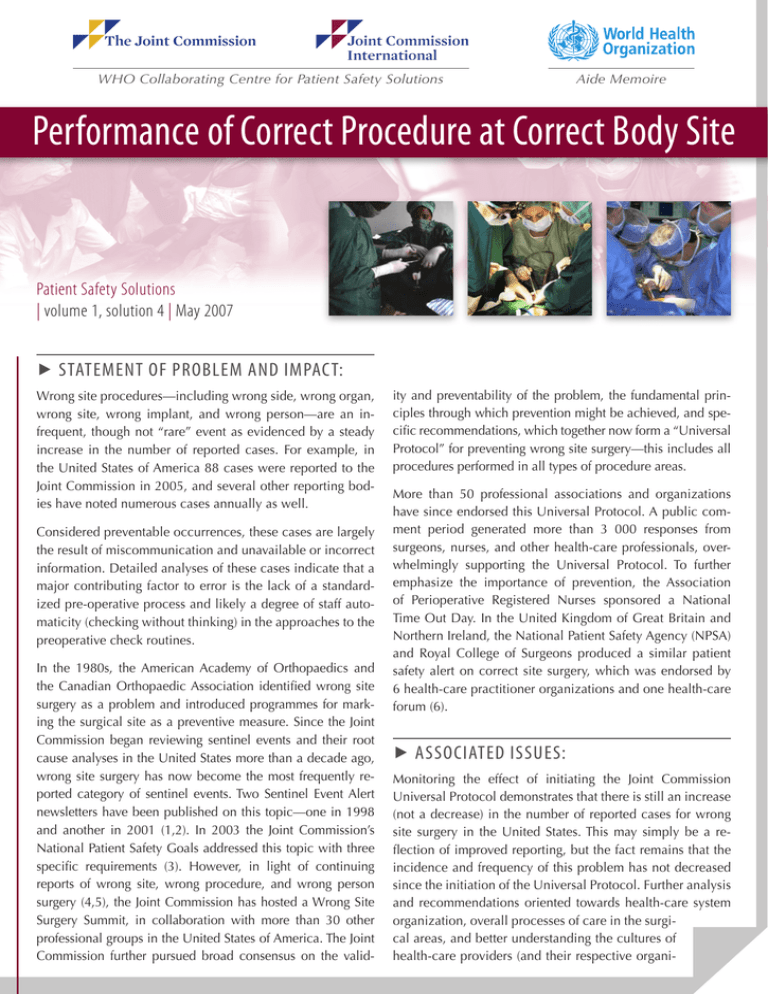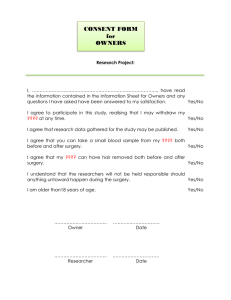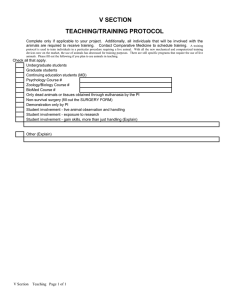
WHO Collaborating Centre for Patient Safety Solutions
Aide Memoire
Performance of Correct Procedure at Correct Body Site
Patient Safety Solutions
| volume 1, solution 4 | May 2007
▶ Statement of Problem and Impact:
Wrong site procedures—including wrong side, wrong organ,
wrong site, wrong implant, and wrong person—are an infrequent, though not “rare” event as evidenced by a steady
increase in the number of reported cases. For example, in
the United States of America 88 cases were reported to the
Joint Commission in 2005, and several other reporting bodies have noted numerous cases annually as well.
Considered preventable occurrences, these cases are largely
the result of miscommunication and unavailable or incorrect
information. Detailed analyses of these cases indicate that a
major contributing factor to error is the lack of a standardized pre-operative process and likely a degree of staff automaticity (checking without thinking) in the approaches to the
preoperative check routines.
In the 1980s, the American Academy of Orthopaedics and
the Canadian Orthopaedic Association identified wrong site
surgery as a problem and introduced programmes for marking the surgical site as a preventive measure. Since the Joint
Commission began reviewing sentinel events and their root
cause analyses in the United States more than a decade ago,
wrong site surgery has now become the most frequently reported category of sentinel events. Two Sentinel Event Alert
newsletters have been published on this topic—one in 1998
and another in 2001 (1,2). In 2003 the Joint Commission’s
National Patient Safety Goals addressed this topic with three
specific requirements (3). However, in light of continuing
reports of wrong site, wrong procedure, and wrong person
surgery (4,5), the Joint Commission has hosted a Wrong Site
Surgery Summit, in collaboration with more than 30 other
professional groups in the United States of America. The Joint
Commission further pursued broad consensus on the valid-
ity and preventability of the problem, the fundamental principles through which prevention might be achieved, and specific recommendations, which together now form a “Universal
Protocol” for preventing wrong site surgery—this includes all
procedures performed in all types of procedure areas.
More than 50 professional associations and organizations
have since endorsed this Universal Protocol. A public comment period generated more than 3 000 responses from
surgeons, nurses, and other health-care professionals, overwhelmingly supporting the Universal Protocol. To further
emphasize the importance of prevention, the Association
of Perioperative Registered Nurses sponsored a National
Time Out Day. In the United Kingdom of Great Britain and
Northern Ireland, the National Patient Safety Agency (NPSA)
and Royal College of Surgeons produced a similar patient
safety alert on correct site surgery, which was endorsed by
6 health-care practitioner organizations and one health-care
forum (6).
▶ Associated Issues:
Monitoring the effect of initiating the Joint Commission
Universal Protocol demonstrates that there is still an increase
(not a decrease) in the number of reported cases for wrong
site surgery in the United States. This may simply be a reflection of improved reporting, but the fact remains that the
incidence and frequency of this problem has not decreased
since the initiation of the Universal Protocol. Further analysis
and recommendations oriented towards health-care system
organization, overall processes of care in the surgical areas, and better understanding the cultures of
health-care providers (and their respective organi-
zations) are warranted. Specific attention is also needed
to evaluate the involvement of surgeons and other team
members. The problem will require a combination of system organization commitment and modification of individual behaviours to improve the outcomes.
The principles for this Solution should apply to all areas
where interventions are performed and, if used, the strategy should be performed uniformly in all procedural areas
at all times in order to provide consistency and increased
compliance.
▶ Suggested actions:
The following strategies should be considered by WHO
Member States.
1. Establish the performance of correct surgery at the
correct body site as a health-care facility safety priority that requires leadership and the active engagement of all frontline practitioners and other healthcare workers.
2. Ensure that health-care organizations have in place
protocols that:
► Provide for verification—at the preprocedure
stage—of the intended patient, procedure, site,
and, as applicable, any implant or prosthesis.
► Require the individual performing the procedure
to unambiguously mark the operative site with the
patient’s involvement, to correctly identify the intended site of incision or insertion.
► Require the performance of a “time-out” 1 with all
involved staff immediately before starting the procedure (and the related anaesthetic). The time-out
is to establish agreement on the positioning of the
intended patient on the procedure table, procedure,
site, and, as applicable, any implant or prosthesis.
1 - “Time out” is a specifically allocated period where no clinical activity is taking place. During this time, all team members independently verify the impending clinical action.
▶ Looking forward:
Member States should consider:
▶ Monitoring the ongoing frequency and incidence of
wrong site procedures as part of voluntary reporting
systems.
▶ Using any incident reports to promote multidisciplinary
collaborations to promote systems-based change in all
procedure areas.
▶ Strength of Evidence:
▶ Analyses from the Joint Commission Sentinel Event
database and the American Academy of Orthopaedic
Surgeons database.
▶ Expert consensus.
▶ Applicability:
▶ Hospitals, ambulatory care facilities, and office-based
surgical facilities.
▶ Opportunities for Patient and
Family Involvement:
▶ Involve patients at all points in the preoperative verification process to reconfirm with the procedure staff their
understanding for the planned procedure.
▶ Involve patients in the surgical site marking process,
whenever possible.
▶ Discuss these issues during the informed consent process and confirm decisions at the time of signature for the
consent.
▶ Potential Barriers:
▶ Lack of surgeon “agreement” to the standardized approach and difficulty to change the culture.
▶ Failure to recognize risks in procedural settings other
than the operating room.
▶ Reluctance of nurses and other staff to question the surgeon when a possible error is identified.
▶ Inadequate human resources and knowledge for facilitating processes to be challenged.
▶ “Automatic” behavior during the time-out process
(“going through the motions” but without meaningful
communication).
▶ Insufficient generally accepted research, data, and
economic rationale regarding cost-benefit analysis
or return on investment (ROI) for implementing these
recommendations.
▶ Risks for Unintended
Consequences:
▶ Inconsistent interpretation of an “X” marking to “operate
here” versus “do not operate here”.
▶ Inconsistency of Universal Protocol procedures among
several hospitals within a geographic area, staffed
by the same surgeons operating at more than one of
the hospitals.
▶ Permanent tattooing of immature skin
(premature infants).
▶ Perception of increased workload by staff and decreased
efficiencies.
EXAMPLE OF
Performance of Correct Procedure at Correct Body Site
Policy
Practitioner
Provider
Organization policy describes standardized approach to ensure that correct procedures are
consistently performed on correct patients.
Correct
Diagnosis &
Procedure
Planning
Conduct informed consent process:
► Inform patient and family about procedure rationale, plans,
options, risks.
► Obtain and document consent for all procedures, including full name
of procedure, site, anaesthesia plan or preferences.
Day
of
Procedure
Pre-Procedure Verification:
► Ensure practitioners have current information on the patient’s medical
status and proposed procedure plans - obtain the patient record.
► Verify all relevant entries, including the informed consent document,
are present and properly identified for the correct patient.
► Obtain relevant laboratory tests and imaging studies and verify
correct patient identification on images.
Practitioner
Pre-Op
Holding Area
Patients
Operating/
Procedure Room
Practitioner
Proceed with
Correct Procedure
Patients
Mark The Procedure Site:
► Marked by person who will do the procedure.
► Use indelible marker.
► Mark the practitioner’s initials.
► Have patient confirm site and markings.
Conduct “Time-Out”:
► Verify correct patient (2 IDs).
► Verify planned procedure.
► Verify procedure site.
► Verify correct positioning on procedure table.
► Verify availability of special equipment, implants, or prosthesis.
Engage patients and families in all aspects of care. Provide patients with information about their medical
condition and proposed procedure plans in a way that is understandable to the patient at all times.
This example is not necessarily appropriate for all health-care settings.
▶ References:
1.
Lessons learned: wrong site surgery. Sentinel Event Alert, Issue 6, 28 August 1998. Joint Commission. http://
www.jointcommission.org/SentinelEvents/SentinelEventAlert/sea_6.htm.
2.
A follow-up review of wrong site surgery. Sentinel Event Alert, Issue 24, 5 December 2001. Joint Commission.
http://www.jointcommission.org/SentinelEvents/SentinelEventAlert/sea_24.htm.
3.
2003 National Patient Safety Goals. Oakbrook Terrace, IL: Joint Commission, 2003 (http://www.acha.org/
info_resources/jcaho2_02.pdf, accessed 12 June 2006).
4.
Statement on ensuring correct patient, correct site, and correct procedure surgery. Bulletin of the American
College of Surgeons, 87:12, December 2002. http://www.facs.org/fellows_info/statements/st-41.html.
5.
AAOS launches 2003 public service ad campaign. AAOS Bulletin, February 2003. American Academy of
Orthopaedic Surgeons’ “Sign Your Site” initiative.
6.
Correct site surgery alert. London: National Patient Safety Agency, 2 March 2005.
▶ Other Selected Resources:
1.
National Quality Forum (NQF) Safe Practices for Better Health Care, Link: http://www.qualityforum.
org/projects/completed/safe_practices/
2.
NPSA Alert, Link: http://www.npsa.nhs.uk/site/media/documents/883_CSS%20PSA06%20FINAL.pdf
3.
The Universal Protocol Tool, Link: http://www.jcipatientsafety.org/show.asp?durki=10815&site=149&return=9334.
© World Health Organization 2007
All rights reserved. Publications of the World Health Organization can be obtained from WHO Press, World Health Organization, 20 Avenue Appia, 1211
Geneva 27, Switzerland (tel.: +41 22 791 3264; fax: +41 22 791 4857; e-mail: bookorders@who.int ). Requests for permission to reproduce or translate
WHO publications – whether for sale or for noncommercial distribution – should be addressed to WHO Press, at the above address (fax: +41 22 791
4806; e-mail: permissions@who.int ).
The designations employed and the presentation of the material in this publication do not imply the expression of any opinion whatsoever on the part of
the World Health Organization concerning the legal status of any country, territory, city or area or of its authorities, or concerning the delimitation of its
frontiers or boundaries. Dotted lines on maps represent approximate border lines for which there may not yet be full agreement.
Thementionofspecificcompaniesorofcertainmanufacturers’productsdoesnotimplythattheyareendorsedorrecommendedbytheWorldHealthOrganization
in preference to others of a similar nature that are not mentioned. Errors and omissions excepted, the names of proprietary products are distinguished by initial
capital letters.
All reasonable precautions have been taken by the World Health Organization to verify the information contained in this publication. However, the published material is being distributed without warranty of any kind, either expressed or implied. The responsibility for the interpretation and use of the material
lies with the reader. In no event shall the World Health Organization be liable for damages arising from its use.
This publication contains the collective views of the WHO Collaborating Centre for Patient Safety Solutions and its International Steering Committee and
does not necessarily represent the decisions or the stated policy of the World Health Organization.






